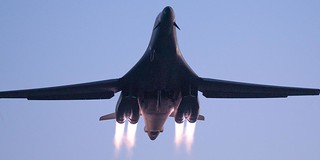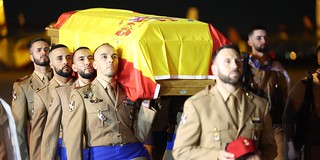An airman shows the interior of the E-3 Sentry, the sophisticated radar aircraft operated by NATO
The air defense of NATO territory depends mainly on the air forces of the member countries of the Atlantic Alliance.
Countries that lack their own fighter aircraft, such as the Baltic republics, receive support from NATO's Baltic Air Policing (BAP) missions, with fighters contributed by other allied nations. The air forces of NATO countries are coordinated through Allied Air Command (AIRCOM), based in Ramstein, Germany. But in addition to the military aircraft of the allied countries, NATO itself has some aircraft that bear the organization's emblem and are manned by personnel from several countries. Among them are 14 AWACS E-3A Sentry and 5 Northrop Grumman RQ-4 Global Hawk drones.

NATO approved the purchase of 18 E-3A Sentry in 1978, being delivered between February 1982 and May 1985. The Sentry, based on the Boeing 707, is a radar aircraft strong>, or more technically, an Airborne Warning and Control System (AWACS), which serve to cover from the air those parts of the airspace that ground radars leave exposed. In addition to controlling NATO airspace, these aircraft have collaborated in the Alliance's air operations in Afghanistan and Libya, and are also contributing to the surveillance of allied airspace in the face of the war in Ukraine.

The distinctive feature of the E-3 Sentry is the radome of its AN/APY-1 radar antenna, circular in shape and located on the rear half of the fuselage. "Under normal circumstances, the aircraft operates for about eight and a half hours, at 30,000 feet (9,150 metres) and covers a surveillance area of more than 120,000 square miles (310,798 square kilometres). The aircraft is capable of flying longer operations due to its air-to-air refuelling capability", the NATO points out.

NATO currently has two E-3A squadrons with 14 of these aircraft, which are based in Geilenkirchen, Germany, a military base that depends directly on NATO. The planes are part of the so-called NATO Airborne Early Warning and Control Force (NAEW&C Force). Currently, this force has 30 crews with personnel from 17 NATO member countries: Germany, Belgium, Denmark, Spain, the United States, Greece, Hungary, Italy, Norway, the Netherlands, Poland, Portugal, Romania and Turkey. Each E-3A arrives with two pilots, a navigator, a flight mechanic and up to 19 commanders and operators of the air control and communications systems.

As a curiosity, all NATO E-3s are registered in Luxembourg and carry the military emblem of that country on their wings. In fact, for years they have been the only military aircraft with the Luxembourg military emblem, until this country bought an A400M Atlas in 2020 in a joint order with Belgium. NATO plans to keep its E-3A active until 2035. The Alliance Future Surveillance and Control (AFSC) program has already been launched to find a replacement.
Today Forces News has published an interesting video in which one of the airmen of a NATO E-3A Sentry shows the interior of one of these aircraft, explaining the purpose of the different consoles and systems that carries on board:
---
Main photo: NATO.
|
Don't miss the news and content that interest you. Receive the free daily newsletter in your email: |
- Most read
- US F-35A fighters flying with Polish F-16s over Poland at a time of great tension
- The Harrier IIs of the Spanish Navy fly with F-16 and F-4E of the Hellenic Air Force
- The brutal 'touch and go' of a Lufthansa Boeing 747 at Los Angeles Airport
- The loading of two Spanish CH-47F Chinook helicopters on a Ukrainian Antonov An-124
- The deployment of Spanish soldiers of the Regulars and BRILAT near Russian territory
- Eurofighter vs F-35: the opinions of professional pilots on these advanced fighters
- Sierra Army Depot, a huge United States base with hundreds of Abrams tanks stored

 ES
ES







Opina sobre esta entrada: